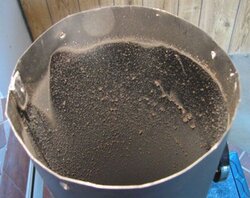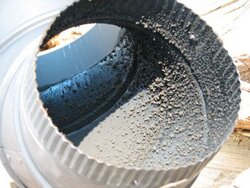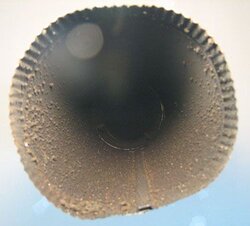With just basic math two 45 degree elbows would make 90...but, in the case of smoke and draft, would it benefit me to make a change to my existing installation?
Free standing wood stove. Single wall pipe straight up 3', 90 degree elbow, another 3' straight to outside connector. Currently my draft is okay, but I do am having trouble keeping my stack above 250, and worry big time about creosote buildup in my little, cheap, single wall pipe. (that's getting replaced with double wall next year, but not in the budget for now). Anyway, as the smoke flows, would it increase the draft at all if I came out of the stove at a 45 degree angle, straight for about 3', and then another 45 degree to get it to the outside connector? I don't want to have to extend my chimney higher if I can help it since it already towers over the house and would probably need lines to hold it in place. If I can acheive the equivalent of another foot, that might help my draft situation substantially. Would things flow better this way? I'm thinking the 3' less of pipe alone might do it no less the harsh right angle.
On another note, I called a chimney sweep hoping to get some insight into my various problems. I asked him whether enclosing my completely exterior class A chimney would help my situation regarding burn times, draft, and stack temperature. He said that class A chimneys are more than adequately insulated and I would be wasting my money to enclose it. I know that, in a previous post, that someone here said that I enclosing my chimney could help hold the heat up to 80 percent better. It's got me confused. If there's any hard fact, web sites to document such, I'd really like to get to the cold hard facts.
Free standing wood stove. Single wall pipe straight up 3', 90 degree elbow, another 3' straight to outside connector. Currently my draft is okay, but I do am having trouble keeping my stack above 250, and worry big time about creosote buildup in my little, cheap, single wall pipe. (that's getting replaced with double wall next year, but not in the budget for now). Anyway, as the smoke flows, would it increase the draft at all if I came out of the stove at a 45 degree angle, straight for about 3', and then another 45 degree to get it to the outside connector? I don't want to have to extend my chimney higher if I can help it since it already towers over the house and would probably need lines to hold it in place. If I can acheive the equivalent of another foot, that might help my draft situation substantially. Would things flow better this way? I'm thinking the 3' less of pipe alone might do it no less the harsh right angle.
On another note, I called a chimney sweep hoping to get some insight into my various problems. I asked him whether enclosing my completely exterior class A chimney would help my situation regarding burn times, draft, and stack temperature. He said that class A chimneys are more than adequately insulated and I would be wasting my money to enclose it. I know that, in a previous post, that someone here said that I enclosing my chimney could help hold the heat up to 80 percent better. It's got me confused. If there's any hard fact, web sites to document such, I'd really like to get to the cold hard facts.




